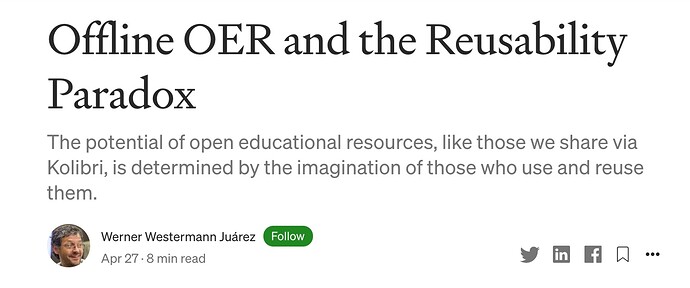Thanks to Alan and others for the invitation to participate in this conversation.
If you didn’t make it all the way through my 2002 article linked above (and I wouldn’t blame you!), the Reusability Paradox can be stated in its simplest form as follows:
- There is an inverse relationship between the amount a student can learn from a resource and the reusability of the resource.
- “Larger” resources like a complete module - which may include text, images, interactives, practice with feedback, etc. - can support significant student learning BUT are reusable only in a very small number of circumstances. (How many places can you reuse an entire chapter on sonata form?)
- “Smaller” resources like an individual image are reusable in a wide range of circumstances BUT support very little student learning. (How much can a student learn from an isolated photograph of an orchestra?)
In the 1990s when I first posited the reusability paradox, the assumption was that learning resources would be traditionally copyrighted. (I didn’t release the OpenContent License until 1998, and Creative Commons wouldn’t come along until the 2000s.) In the context of traditionally copyrighted resources - that is, when others could not make edits to the resources - the instructional designer had to choose between creating resources that were more effective but less reusable, or resources that were more reusable but less effective. Neither choice was ideal, and the “Goldilocks zone” in the middle of these two options turns out to be extremely narrow.
Open licensing resolves the reusability paradox. When a larger resource (like a complete module) is openly licensed, it can be designed to support meaningful student learning AND - thanks to the 5R permissions that come with open licenses - be customizable to fit into different contexts.
Problem solved, right? 
The resolution of the reusability paradox by means of open licensing leads to two new problems. The first problem is that not everyone has the time, resources, and technical expertise necessary to engage in the significant amount of revising and remixing necessary to tailor a larger resource to a specific context. Plenty has been written about this issue elsewhere, so I will not linger on it here.
The second, far less discussed problem is that not everyone has the instructional design and learning science expertise necessary to understand why a specific larger resource might effectively support student learning. For example, a person who is not familiar with the principle of spaced rehearsal wouldn’t be able to “see” spaced rehearsal at work in the design of the resource, and their revising and remixing could easily undo this aspect of the original instructional design. In other words, even if a person has the time, resources, and technical expertise to revise and remix an open educational resource, the localization process may very well reduce the effectiveness of the resource rather than improve it.
Here we can name and state a new paradox. I will call it “the Localization Paradox.” The localization paradox states that when a person without a deep understanding of instructional design and learning science revises and remixes an open educational resource to better fit their specific context, they may unknowingly remove (or otherwise render ineffective) the instructional design features of the resource. What’s worse, the detrimental effects of their revising and remixing will be just as invisible to them as the instructional design features of the original resource were. (They will never know they’ve broken it.)
Will any increase in student learning attributable to the localization outweigh any decrease in student learning attributable to the localization?
Note that some OER are immune to the localization paradox. (Before you proceed, pause to ponder why that might be true.) This is because these OER are created by people with a deep understanding of their discipline (e.g., physics, accounting, literature) but no training in instructional design or learning science. This results in OER that are largely informational and lack any instructional design features. For example, take an open textbook that contains accurate explanations of key facts, concepts, principles, and procedures in a discipline. This is essentially a reference work without much that is explicitly instructional in its design. Because OER like this include few instructional design features there is little to “break” during the localization process, and little harm can be done by revising and remixing them.
This leads us straight back to something like the reusability paradox. Should authors create OER that function more like reference works, without explicitly instructional features - minimizing their educational effectiveness in order to maximize their localizability? Or should authors create explicitly instructional OER that will support better student learning, knowing they will require significantly more expertise to localize effectively?
I would suggest that we should always design the most educationally effective resource we can. If its instructional design features are removed or rendered ineffective during localization, the result will be an informational resource fit for use the new context. In other words, in the worst case scenario the result of the localization process would be the same (a reference work) regardless of whether the original OER was informational or instructional.


 Thanks for hosting these great discussions!
Thanks for hosting these great discussions!